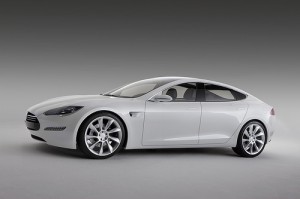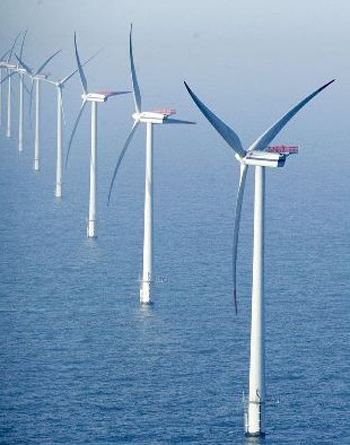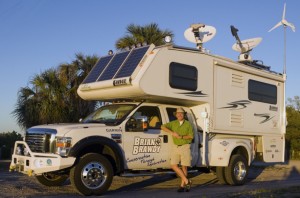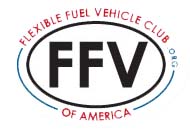 In the race to develop and produce more efficient electric vehicles, Bright Automotive has launched a brand-new, 100-mpg plug-in hybrid electric (PHEV) fleet vehicle –The IDEA. This is one of the first PHEVs designed “for the people by the people,” to compete in the light-duty truck market. The vehicle offers 180 cubic feet of interior space and a 1-ton payload capacity. Perfect, claims Bright, for commercial fleet use.
In the race to develop and produce more efficient electric vehicles, Bright Automotive has launched a brand-new, 100-mpg plug-in hybrid electric (PHEV) fleet vehicle –The IDEA. This is one of the first PHEVs designed “for the people by the people,” to compete in the light-duty truck market. The vehicle offers 180 cubic feet of interior space and a 1-ton payload capacity. Perfect, claims Bright, for commercial fleet use.
Beginning in 2012, the company plans to be produce 50,000 vehicles per year that will provide companies and government agencies, such as the post office, with a cost-saving, eco-friendly American made fleet vehicle. But maybe more interesting than its features and fuel-economy, is that Bright Automotive developed the IDEA in less than one year. It has taken some companies, such as GM, years to develop PHEVs such as the Chevy Volta, which has yet to begin full-scale production, and on average current hybrid vehicles have yet to achieve more than 60 mpg. It looks like the smaller auto companies, such as Tesla Motors and Bright Automotive are poised to own the PHEV market.
 The company, based in Andersen, Indiana was formed in January 2008 as an offshoot of the Rocky Mountain Institute and haspartners that include Alcoa, Google.org, Johnson Controls and the Turner Foundation. Consumers got their first preview of The IDEA on April 8th and Washington lawmakers were able to drive around town on April 21st. The worldwide unveiling of the IDEA will be in May at the Electric Vehicle Symposium (EVS24) in Norway.
The company, based in Andersen, Indiana was formed in January 2008 as an offshoot of the Rocky Mountain Institute and haspartners that include Alcoa, Google.org, Johnson Controls and the Turner Foundation. Consumers got their first preview of The IDEA on April 8th and Washington lawmakers were able to drive around town on April 21st. The worldwide unveiling of the IDEA will be in May at the Electric Vehicle Symposium (EVS24) in Norway.
So how does it work? It is unique in that on a full charge, the IDEA uses battery power for the first 30 miles, using little to no gasoline. Once the driver exceeds 30 miles, the car functions like other hybrids. When you factor in battery vs gas usage plus miles driven, say 50 miles, the car gets the equivalent of 100 mpg.
The IDEA should prove to both American consumers and Washington DC policy makers that PHEVs are a reality and will hopefully encourage American automakers to step up their research development and production of electric vehicles.
 organization “Great Nonprofits” wants you to vote for their Green Choice Awards which honors local nonprofit environmental organizations that are doing great things in your neighborhood, community or the world.
organization “Great Nonprofits” wants you to vote for their Green Choice Awards which honors local nonprofit environmental organizations that are doing great things in your neighborhood, community or the world.

 The
The  Graceful wind turbines turning in the plentiful breezes off the Upstate New York shores of Lake Erie and Lake Ontario might soon become a reality.
Graceful wind turbines turning in the plentiful breezes off the Upstate New York shores of Lake Erie and Lake Ontario might soon become a reality. All you’ll see coming out of its tailpipe is clean water vapor. It’s no wonder that Honda’s hydrogen-powered FCX Clarity picked up World Green Car of the Year honors at the recent New York Auto Show.
All you’ll see coming out of its tailpipe is clean water vapor. It’s no wonder that Honda’s hydrogen-powered FCX Clarity picked up World Green Car of the Year honors at the recent New York Auto Show. But one man isn’t waiting until summer to get his adventure going. In fact, in the past year, Brian Brawdy has driven more than 60,000 miles in his biodiesel, wind and solar powered RV throughout the lower 48. This story from the
But one man isn’t waiting until summer to get his adventure going. In fact, in the past year, Brian Brawdy has driven more than 60,000 miles in his biodiesel, wind and solar powered RV throughout the lower 48. This story from the  to turn more than 1 billion pounds of manure into fuel for the boilers that supply steam for the plant, was sold to its creditors for $25 million in credit. Societe Generale, is the lender and the administrative agent for the lending syndicate, that was awarded the plant. The Hereford Biofuels plant filed for Chapter 11 bankruptcy in January of this year and was owned by
to turn more than 1 billion pounds of manure into fuel for the boilers that supply steam for the plant, was sold to its creditors for $25 million in credit. Societe Generale, is the lender and the administrative agent for the lending syndicate, that was awarded the plant. The Hereford Biofuels plant filed for Chapter 11 bankruptcy in January of this year and was owned by  The Ethanol Across America education campaign has announced its support of the National Flexible Fuel Vehicle (FFV) Awareness Project in cooperation with the FlexFuel Vehicle Club of America. The FlexFuel Vehicle Club was founded to build a national support base of FFV owners and other related stakeholders. The goal of the project is to accelerate and support existing consumer education efforts to increase ethanol demand through the sale of high level blends of ethanol to meet the nation’s renewable fuel standard.
The Ethanol Across America education campaign has announced its support of the National Flexible Fuel Vehicle (FFV) Awareness Project in cooperation with the FlexFuel Vehicle Club of America. The FlexFuel Vehicle Club was founded to build a national support base of FFV owners and other related stakeholders. The goal of the project is to accelerate and support existing consumer education efforts to increase ethanol demand through the sale of high level blends of ethanol to meet the nation’s renewable fuel standard. “Consumers are becoming more aware of the impact of their energy usage on the environment. Consumers have the choice to turn off a light, change a bulb, or even buy green energy (e.g., wind, solar, hydro) from their local utility. However, the vast majority of consumers still do not have the choice of what fuel to put in their cars unless they are one of the 7 million owners of FFVs. We are launching this national FFV awareness campaign so more consumers will begin to use their power of choice and purchase higher than 10% blends of ethanol,” said Burl Haigwood, President of the FlexFuel Vehicle Club.
“Consumers are becoming more aware of the impact of their energy usage on the environment. Consumers have the choice to turn off a light, change a bulb, or even buy green energy (e.g., wind, solar, hydro) from their local utility. However, the vast majority of consumers still do not have the choice of what fuel to put in their cars unless they are one of the 7 million owners of FFVs. We are launching this national FFV awareness campaign so more consumers will begin to use their power of choice and purchase higher than 10% blends of ethanol,” said Burl Haigwood, President of the FlexFuel Vehicle Club.  In the race to develop and produce more efficient electric vehicles,
In the race to develop and produce more efficient electric vehicles,  The company, based in Andersen, Indiana was formed in January 2008 as an offshoot of the Rocky Mountain Institute and haspartners that include Alcoa, Google.org, Johnson Controls and the Turner Foundation. Consumers got their first preview of The IDEA on April 8th and Washington lawmakers were able to drive around town on April 21st. The worldwide unveiling of the IDEA will be in May at the Electric Vehicle Symposium (EVS24) in Norway.
The company, based in Andersen, Indiana was formed in January 2008 as an offshoot of the Rocky Mountain Institute and haspartners that include Alcoa, Google.org, Johnson Controls and the Turner Foundation. Consumers got their first preview of The IDEA on April 8th and Washington lawmakers were able to drive around town on April 21st. The worldwide unveiling of the IDEA will be in May at the Electric Vehicle Symposium (EVS24) in Norway. There is a lot of dialogue surrounding the best way to create energy and environmental policies, specifically around greenhouse gas emissions. The
There is a lot of dialogue surrounding the best way to create energy and environmental policies, specifically around greenhouse gas emissions. The 